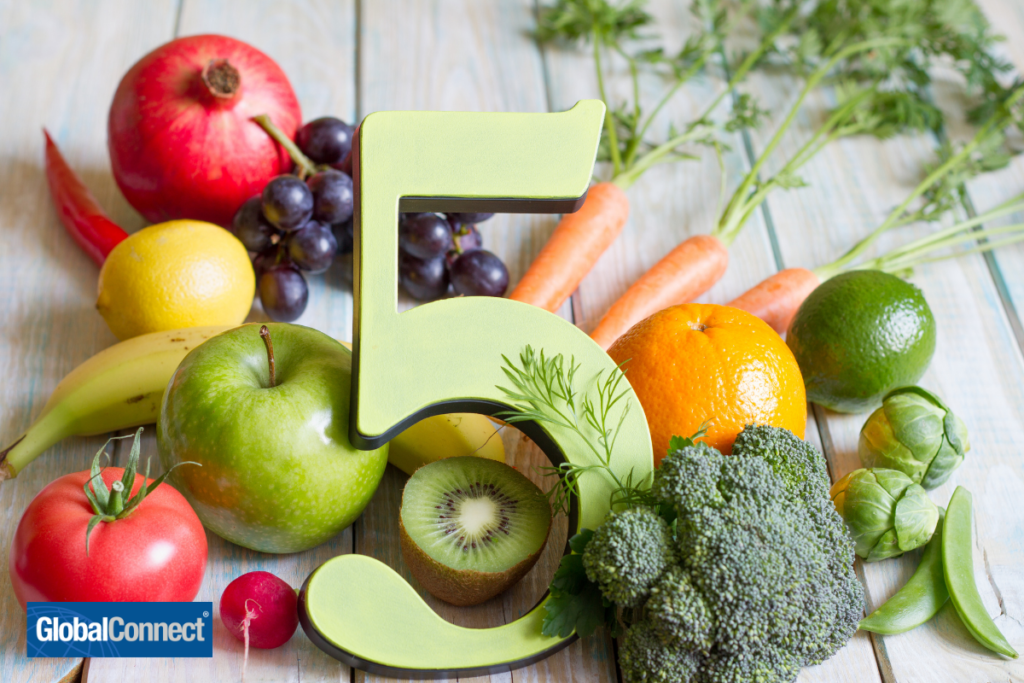A healthy diet is often described as one that is rich in fruits and vegetables. But how many servings of produce per day is enough to really reap the health benefits? Is it five? Seven? More or less?
Five per day keeps the doctor away.
The standard guideline has been five servings of fruits and vegetables per day for the average adult. And a 2021 Harvard study confirmed that five per day offers the strongest health benefits. Participants in the study who regularly consumed five servings of fruits and vegetables per day had a 13 percent lower risk of death from any cause, a 12 percent lower risk of dying from heart disease or stroke, a 10 percent lower risk of death from cancer, and a 35 percent lower risk of death from respiratory disease. Contrary to other past studies, any portions beyond the recommended five do not appear to have a further impact on mortality.
Fresh fruits and vegetables are the main sources of many nutrients (such as potassium, magnesium, fiber, and antioxidants) that foster good health, especially for a healthy heart and blood vessels.
The greatest benefit comes from eating leafy green vegetables such as spinach or kale, and fruits and veggies rich in Vitamin C and beta carotenes like berries, carrots, and citrus fruits. Of course, the true benefits come from eating the whole fruit or vegetable, not drinking the juice. Starchy vegetables like corn or potatoes don’t seem to offer the same benefits as their more colorful counterparts.
Five per day is the easy way.
Most people are aware that they aren’t eating enough fruits or vegetables, but how can you work them into your diet every day to meet the recommended amount? There are lots of easy and delicious ways to sneak more fruits and vegetables into your day!
Prep ahead of time.
As soon as you bring home your produce from the grocery store, go ahead and peel and cut veggies such as carrots, celery, and cucumbers, and put them into food storage containers in the refrigerator. Keep them readily visible in your fridge so you can easily grab them for a quick and healthy snack.
Greens before grains.
When meal planning, substitute a green vegetable for a grain such as rice or bread. You can offer cauliflower rice, a salad, green beans, or asparagus as a side dish for dinner, for example.
Meatless Mondays.
It doesn’t necessarily have to be Monday, but choose one day per week where you refrain from eating meat. Instead, opt for veggie burgers, pasta with loads of veggies and tomato sauce, or a veggie casserole or quiche. Get creative and find vegetarian options for your favorite dishes and experiment with new meat-free meals every week.
Puree veggies.
This works especially well for picky kids and picky adults alike. Add pureed carrots to spaghetti sauce, spinach or kale to smoothies, or broccoli to macaroni and cheese.
Start the day with fruits and veggies.
Start your morning with a piece of fruit: a banana or berries and Greek yogurt. Or cook veggies like mushrooms or spinach into an omelet.
Swap your grains.
Substitute pasta noodles for zucchini noodles or spaghetti squash. Try cauliflower rice, pizza crust, or wraps in place of white rice, traditional pizza crust, or bread.
Eat a salad each day.
Start either your lunch or dinner meal with a salad made with a cup of greens and two other colorful veggies chopped up with your favorite salad dressing.
The 1-2-3 approach.
Follow the 1-2-3 approach: have one fruit serving with breakfast, two fruit or vegetable servings with lunch, and three vegetable servings with dinner.
